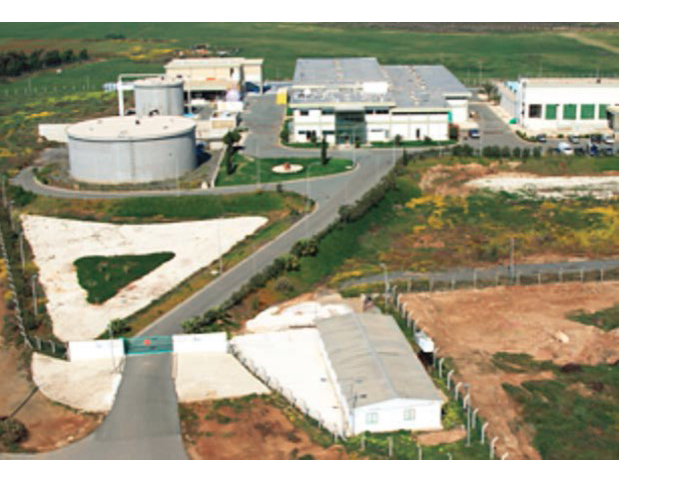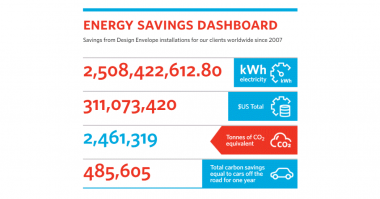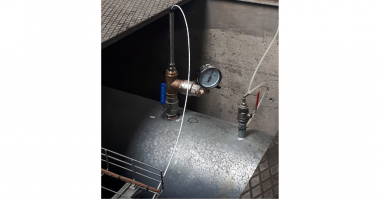Facing increasing energy costs, the Cyprus Water Department decided to upgrade the desalination plant in Larnaca. The plant’s owners challenged M.N. Larnaca Desalination and Flowserve to optimize the efficiency of the plant with DWEER™ energy recovery devices (ERDs) within the facility’s current footprint.
Flowserve optimized the Larnaca plant with improved high-pressure (HP) pumps, DWEERs and related state-of-the-art technologies. The new design exceeded efficiency targets and reduced maintenance costs. Annual energy savings alone will be more than €6 million per year. It was decided to install an additional DWEER per train to further improve the efficiency. Assuming an average energy cost of €0.15/kWh, this additional investment will save €30 000 in energy per year, justifying the ROI in less than three years.
By dealing with only one vendor for all the pumps and ERDs, M.N. Larnaca Desalination not only saved capital, but also lowered the cost for evaluating and coordinating the engineering details of multiple vendors, a true win-win for both parties.
Flowserve supplied the complete turbine/motor/ pump unit, including a Calder™ Energy Recovery Pelton Turbine — the most efficient-energy recovery device available at the time. To further increase capacity and performance, the plant was upgraded to a maximum capacity of 64 000 m3/h (16 MGD). The system ran successfully and very reliably for 10 years, with an availability exceeding 99%. By 2011, however, water demand and energy costs were both rising.The Larnaca desalination plant was originally built by IDE Technologies, Ltd. under a 10-year BOOT (Build, Own, Operate, Transfer) contract. The original design capacity of the plant was 48 000 m3/day (12 MGD) with 5+1 trains, resulting in a train capacity of 9600 m3/day (2.4 MGD). The plant was constructed in 2000 and commissioned in 2001. An additional train was ordered soon after installation to increase the capacity of the plant to 54 000 m3/day (13.5 MGD).
When the original 10-year BOOT contract expired, the Cyprus Water Development Department issued a tender for a new plant to be built within the existing plant layout. A consortium of Mekorot Development & Enterprise Ltd. and Netcom Co., called M.N. Larnaca Desalination, ultimately won the bid.
During the bidding process Flowserve was in close contact with M.N. Larnaca to support the project by designing and selecting the most efficient equipment package for pumps and energy recovery devices.
Single Supplier Made Upgrade More Efficient:
Despite the project’s challenges, M.N. Larnaca’s decision to work with a single supplier for pumps and ERS resulted in significant advantages and synergies. As a result, the number and size of units, footprint, plant layout and power consumption could all be optimized. A global project manager provided a single point of contact for all Flowserve equipment and field services. It also reduced the number of spare parts required and simplified inventory management.
Economical Design Delivered Efficiency Savings:
The new Flowserve design replaced the plant’s six original trains with two significantly larger ones, giving the system higherefficiency pumps and isobaric ERDs. Each of the new trains operates at a nominal production capacity of 30 730 m3/h (7.5 MGD). To ensure maximum efficiency under changing conditions, variable frequency drives (VFD) were installed on the intake, HP feed and ERS circulation pumps. Based on the projection in Figure 2, the specific power consumption for the HP section is low, at 2.3 kWh/m3 product.

To meet the new HP pump capacity of 1280 m³/h (5635 gpm) at 540 m (1771 ft) of head, Flowserve selected the 10x16DMX-3
stage model. Although this model guarantees efficiency in excess of 87%, the pump actually achieved a best efficiency point (BEP) of 87.5% when installed.
The new advanced DMX model also offers significant efficiency improvements, including:
Channel rings with 360° guide vanes—Reduce losses and increase efficiency
- 360° bearing support—reduces bearing vibration while increasing bearing life.
- Ringless impellers—Reduce running clearance and improve efficiency while lowering the number of spare parts.
- Stellite™ overlaid stationary rings and impeller hub—Reduce wear and allow for tighter clearances, increasing efficiency
- Redesigned continuous crossover extending more than 180°—reduces crossover losses by 40%, increasing overall pump efficiency.
Improvements to the energy recovery system were critical from the start, but soon became an even bigger concern. After the
contract was signed, energy costs in Cypress surged from €0.15/kWh to more than €0.20/kWh.
After reviewing several possible DWEER rack configurations together, M.N. Larnaca and Flowserve determined that the optimal design would be to install the electrical driven linear actuator and the LinX valve vertically. In addition, the following new
technologies were added:
- Super duplex hydro-formed vessels, delivering the highest accuracy with 100% radiographic inspection to ensure highest possible integrity
- Double-seal LinX pistons, reducing leakage to 0%
- A last-generation check valve design for minimal maintenance and lowest differential head
- An electrical actuator to ensure maximum control and simplicity with minimal maintenance

To optimize capital versus operational costs, the existing brine evacuation of the previously installed Pelton turbines was re-used. As a result, both the head and power consumption of the low pressure (LP) feed pumps could be reduced to a minimum.
A CAPEX/OPEX analysis to establish the optimal number of DWEERs resulted in six DWEERs per train to optimize the
efficiency, representing a production capacity of about 30 000 m3/day, or an installed pumping power of about 2.5 MW.
Friendly and productive cooperation between M.N. Larnaca and Flowserve enabled the efficient commissioning of the new Larnaca desalination plant in the second quarter of 2015.
The guaranteed performance parameters for the DWEER were achieved. While the high-pressure dp was just at the limit, mixing and leakage were better than guaranteed. Thanks to the atmospheric DWEER outlet conditions, the low-pressure feed was only at about 1.3 to 1.4 barg, enabling significant power savings on the low-pressure side of the system.
The electric actuator ensured that noise emissions from the DWEER were minimal — clearly below 80 dBA while managing some of the largest SWRO trains installed worldwide.
The power consumption of the plant (HP section) is in the range of 2.2 to 2.3 kWh/m3, exceeding the parameters of the design.
The Larnaca project clearly illustrates how optimization of capital and operating costs can be achieved by clever, site-specific process designs. Consulting the expertise of the equipment supplier early in the process created significant advantages in achieving the best overall performance. Jointly analyzing the project requirements helped Flowserve and M.N. Larnaca optimize the sizing of the pumping and energy recovery system to find the most efficient and cost-effective solution. And by contracting with one supplier for both the DWEER energy recovery devices and all main pump services, Larnaca was able to gain significant efficiencies not previously experienced.





Comments